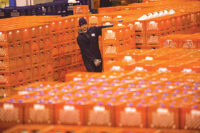
Test-driving Dairy
Sensory analysis and quality testing provide the tools
dairy formulators need to create marketable products.
A car manufacturer wouldn’t dream of
putting a new vehicle on the market — or unveiling changes to an
existing model — without test-driving it first. Yet many
manufacturers continue to introduce products without investing the time to
thoroughly evaluate and understand their attributes.
No matter how innovative the concept or the packaging,
a dairy product is doomed to failure if it does not deliver in terms of
taste, appearance and consistency — or any one of the numerous other
parameters that influence overall quality. Sensory analysis and quality
testing provide the tools formulators need to understand their products and
compete in today’s highly competitive market.
“The more product knowledge you have upfront, the better your
chances are,” says Kathleen Rutledge, president and chief executive officer
of Bartlesville, Okla.-based 21st Sensory Inc. “When you have 80 to 90 percent
failure rates for new product introductions, it just seems short-sighted to
spend a lot of money on packaging and the external of the product and not actually
know much about the internal attributes.”
|
Using the Senses
As its name applies, sensory analysis relies on the
human senses to assess a product’s properties. Formulators can use
its findings to optimize ingredient substitutions, understand how a
product’s attributes compare to those of its competitors or even
reduce costs.
“Sensory analysis is a discipline used to evoke, measure, study
and interpret properties of materials such as food as perceived by the senses
of sight, smell, taste, touch and hearing,” says Grace Brannan, Ph.D., sensory
group leader for Givaudan Flavors Research and Development, Cincinnati. “Analytical
instruments are very useful in determining similarities and differences in products.
However, there is certain information such as consumer liking and interactions
within and across characteristics that only a human panel can provide.”
Sensory analysis can be divided into analytical and
affective analyses, says Brannan. Analytical sensory testing essentially uses a trained
panel as an analytical instrument and combines physiology, psychology and
methodology. Affective testing, on the other hand, relies on consumer
feedback. Combined, these two areas of testing can provide the information
dairy formulators need to better understand their products and markets.
Analytical sensory analysis encompasses activities
such as descriptive analysis and difference testing, says MaryAnne Drake,
Ph.D., an associate professor in North Carolina State University’s
Department of Food Sciences. Affective sensory testing relies on consumer
input from undertakings such as acceptability tests, preference tests and
focus groups.
Gail Vance Civille, president of Chatham, N.J.-based
Sensory Spectrum Inc., looks at analytical and affective sensory analyses
as tools that reveal the “two halves of the truth” about a
product. The first half of the truth uses descriptive panels or some form
of discrimination tests to define the product’s sensory properties
— how it looks, smells and tastes, as well as its textural
attributes. The other half of the truth, she says, relies on consumer
product perceptions.
“The art form is to put those two halves of the truth together
to get at the whole truth,” Civille stresses. “You can’t ask consumers why they
love a product, because they are inarticulate about sensory properties. So if
you take the descriptive information you have — for example, this product has
a higher saltiness, and this product has a lower acidity or whatever — and you
put that together with liking information from the consumer using statistics,
you end up getting a fairly good understanding of the whole truth.”
Human Instruments
Although grading and judging still are used widely to
assess general dairy product quality, “they really do not tell us
about all the attributes and intensity of attributes in a product,”
says Drake. Therefore, descriptive analysis — performed by a panel of
trained sensory experts — is becoming more of a necessity in
today’s very competitive global dairy market.
Drake developed sensory lexicons, or defined sensory
analysis languages, for dairy products ranging from cheddar cheese to
chocolate milk. Civille has collaborated with Drake on some of these
projects, as well as on certain panel training.
Trained sensory panels can use a defined sensory language to
help formulators understand, for example, exactly how their chocolate milk products
compare with competitors’ versions and “what’s out there” in terms of flavor
variability, says Drake. For chocolate milks, Drake’s panel uses a sensory language
that boasts terms such as “malty,” “stale,” “cardboard” and “burnt.”
Effective training is essential to a sensory analysis
panel’s ability to perform descriptive analysis, says Rutledge. Made
up of people who have been tested and shown to have “at least basic
sensory acuities,” each panel typically undergoes intensive training
over a period of several months to learn to recognize and measure food
characteristics. The panel then functions as an analytical instrument, she
says, and its likes and dislikes are “immaterial” to the
analytical work.
Rutledge says her company’s trained panelists “contribute the
absolutes” to the product developer. “In our methodology, we use references
along a scale that anchors the data of the panelists, so over time, from session
to session, you can actually compare data sets,” she says. “They might taste
a chocolate milk and then taste the references, and they can determine what
position that chocolate impact falls along that scale. So then if the product
developer looks at the consumer data (and sees) they want more chocolate, they
can actually change the formulation, bring it back to the panelists and have
them evaluate it again to see if that chocolate impact has moved up correspondingly.”
Givaudan Sensory, which supports the company’s
Savory and Sweet Goods business, uses descriptive analysis to analyze
various cheese varieties and understand the different profiles. The company
uses the information to create “authentic signature profiles”
for process cheese and seasoning blends, says Cindy Ward, Ph.D., senior
sensory manager.
Trained panels also can perform difference testing to
help dairy processors determine the impact an ingredient substitution might
have on a given product.
“You can do a difference test to find out if the flavor is similar
enough,” says Civille. “You can do statistical analysis to actually prove that
it’s similar enough that only a very small portion of the population would ever
notice.”
Difference testing also can substantiate matches to competitive flavors, notes Givaudan’s Ward.
Difference testing also can substantiate matches to competitive flavors, notes Givaudan’s Ward.
On its own, however, such testing is rather limited,
notes Lori Kruse, manager of Sensory Evaluation Services for St. Paul,
Minn.-based Rtech Laboratories, a business unit of Land O’ Lakes Inc.
The results tell formulators whether or not the respondents detect a
difference, but they do not indicate the type or scope of that difference.
Calling on Consumers
Descriptive analysis measures only the intensity of
sensory attributes, not the acceptance of such characteristics, says Kruse.
To gauge product acceptance, Rtech relies on consumer-type testing that
includes product guidance, in-home usage and consumer acceptance
assessments.
For product guidance testing, Rtech recruits Land O’ Lakes employees
to provide acceptance measures of products. “This is usually first step prior
to full-scale consumer testing,” says Kruse. “Product guidance testing results
may be used to benchmark the acceptance of a product compared to competitors
or to determine if a cost-reduced sample is as well liked as the current sample.”
In-home usage testing is appropriate for situations in
which consumer usage is important to product acceptance, says Kruse. For
example, a manufacturer might want to evaluate how a specific cheese
performs in various consumer applications.
Although it might entail a greater financial investment, full-scale
consumer testing can offer a high level of confidence in the results, notes
Kruse. “It uses a large number of consumers specifically selected as those that
purchase the product being evaluated,” she says. “Full-scale consumer testing
may also be conducted in various regions of the country.”
Consumer testing works hand in hand with descriptive
analysis, says Drake. Once a trained panel has used a defined sensory
language to describe the chocolate milks’ flavors, mouthfeel and
other attributes, the formulator then can provide a subset of those milks
to consumers. Researchers then merge consumer-liking data with the
objective analytical sensory information — the profiles of those
products — using a technique called preference mapping.
Preference mapping, says Drake, “allows you to specifically
identify, from an analytical perspective that you can understand, what drives
consumer like and dislike, and what areas are out there that consumers want
or need that are not being provided by existing products.”
Sensory’s Future
The sensory area continues to expand and grow in
sophistication. According to Ward, new research in statistics, physiology,
psychology, psychophysics and molecular biology will help improve the
understanding of how humans experience foods.
Through its “flavor preference research,” Givaudan applies advanced
statistics and experimental design to link “product attributes with consumer
data to generate product profiles and predict consumer liking,” says Ward. The
company has applied this type of research to a wide variety of products, including
chocolate milk, strawberry milk, macaroni and cheese, and strawberry yogurt,
she says, to create “optimized flavors.”
Although innovations such as the “electronic nose” increasingly
will be used to discriminate between good and bad samples and perform other
tasks, instrumentation will never replace the human factor in sensory analysis,
stresses Drake. “There’s never going to be a black box to replace the human
perception of flavor.”
Drake, in collaboration with other researchers,
microbial physiologists and cheesemakers, currently is trying to uncover
ways to accelerate the formation of certain desirable flavors in cheese.
“This is really what the cheese industry has been after for
a long time,” says Drake. “They want to be able to very specifically deliver
the right flavors to the right consumers. Well we have to know how the bacteria
form those flavors, and we have to know about cheese biochemistry, absolutely.
But we also have to know what volatile compounds cause those flavors from a
sensory perspective.”
Beyond Sensory
While sensory testing can help dairy processors
perfect product formulations, other quality tests help ensure that
formulation will hold up under processing or storage conditions.
According to Fred Weber, president of Hamilton,
N.J.-based Weber Scientific, such testing includes the evaluation of
physical, chemical and microbiological kinetics and deterioration for
shelf-life purposes; processing and sanitation related to psychotropic
bacteria; processing preservation levels required; a product’s need
for stabilizers and/or emulsifiers; composition and nutritive value;
regulatory concerns and much more.
Fat and moisture analyses are essential for product
consistency and cost control, says Bobbie McManus, process product manager
for Matthews, N.C.-based CEM Corp.
“The ability to quickly determine the fat
content enables the manufacturers of dairy products to efficiently and
accurately verify the quality of incoming raw materials, check products in
process and make fast adjustments,” says McManus.
CEM’s Smart Trac‘ system uses microwave
energy and nuclear magnetic resonance (NMR) analysis to yield accurate fat
and moisture test results in just minutes, says McManus. The product won
the 2003 National Society of Professional Engineers New Product Award.
Laboratory HTST and UHT equipment and services such as
those provided by Raleigh, N.C.-based MicroThermics allow dairy processors
to do precisely mimic processing conditions. “We allow the formulator
to process their product exactly the same way it’s processed in a
production plant so they know the end-product identity,” says
MicroThermics vice president David Miles, Ph.D.
MicroThermics’ equipment goes hand in hand with
sensory analysis, notes Miles. Essentially, it can be used to match a
previously agreed-upon sensory profile, or it can run numerous formulations
of a product destined for subsequent sensory analysis. The equipment can
run as many as 20 small-quantity batches a day.
New to the company’s product line is a
direct/indirect processor that “does both steam injection and
indirect heating all in one cabinet,” says Miles. “Processors
can select the style of heating, the hold tubes, the number of heating and
cooling stages, and more.”
$OMN_arttitle="Test-driving Dairy";?>
